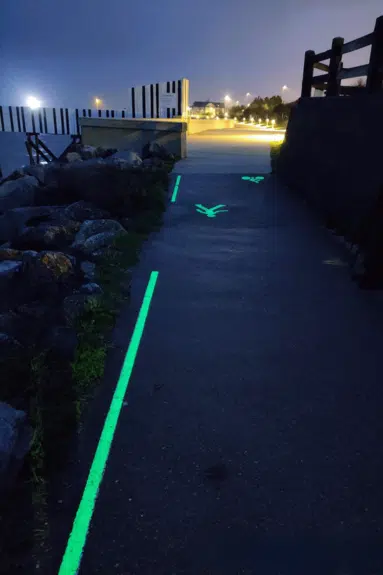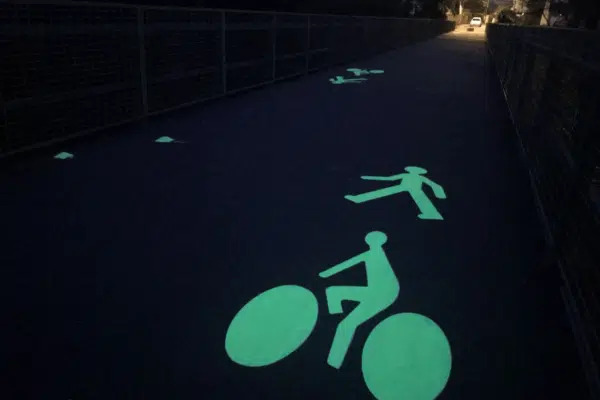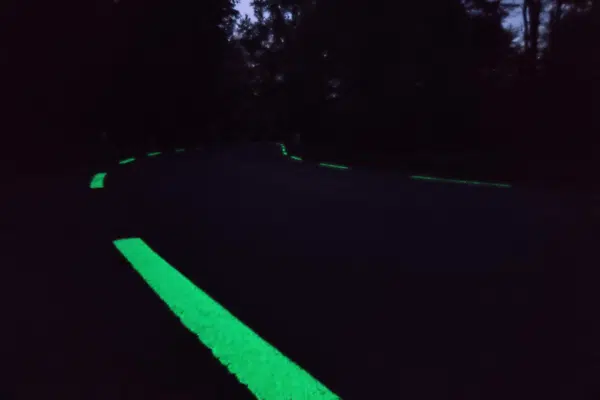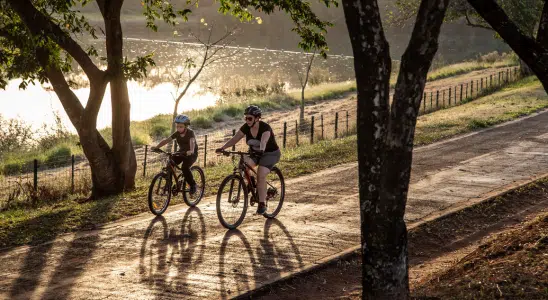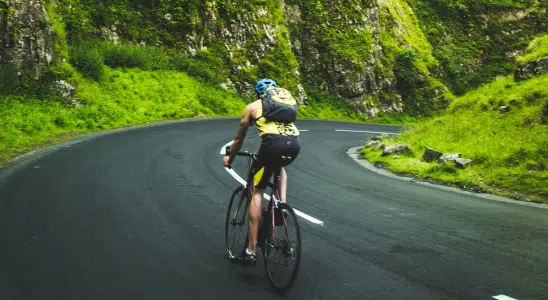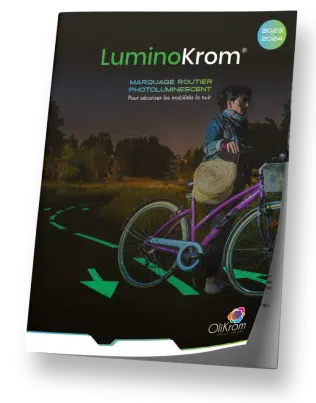Photoluminescence, a technology with economic advantages
LuminoKrom® paint, an economical lighting solution
The use of LuminoKrom® photoluminescent surfacing offers a number of economic advantages for local authorities, particularly in infrastructure and urban development projects.
LuminoKrom® captures natural or artificial light during the day and releases it at night, reducing the need for public and artificial lighting in areas such as bicycle paths, parking lots and pedestrian areas. The result is a significant reduction in electricity consumption costs.
Our technology is designed to be durable, with high resistance to weathering and wear. This reduces maintenance costs compared with conventional lighting systems or other less resistant types of coating.
Increased safety at lower cost
One of the major concerns of local authorities is the safety of public infrastructures, especially at night. Effective lighting helps reduce accidents and make public spaces safer, but it can be costly.
Reduced accidents and associated costs: Better lighting of bicycle paths and pedestrian zones with LuminoKrom® can reduce night-time accidents involving cyclists and pedestrians. Fewer accidents mean lower costs in terms of infrastructure repairs (ramps, barriers, sidewalks) and potentially savings in public health expenditure associated with emergency care. Surfacing improves visibility of traffic lanes at night, which can also reduce vehicle-related accidents, avoiding indirect costs to the community.
Photoluminescent paint: saving renewable energy
Lower energy costs
The main advantage of LuminoKrom® lies in its energy autonomy. Unlike traditional street lighting, which relies on electricity, LuminoKrom® uses the renewable energy of sunlight to charge itself during the day. Our cladding therefore recharges naturally and diffuses a soft light at night, without the need to consume electricity.
Lower electricity bills. A local authority may consider reducing or completely switching off street lighting in certain areas, leaving LuminoKrom® to ensure sufficient visibility for users, particularly on cycle paths or footpaths. Over several years, the energy savings can represent a considerable amount, especially in areas where street lighting is expensive to maintain (rural areas, parks, etc.).
Simple, low-maintenance
Unlike traditional lighting infrastructures, which require frequent maintenance (repairing lamp posts, replacing bulbs, cleaning, checking electrical circuits), LuminoKrom® coating is much more durable and resilient.
Lower maintenance costs. Once applied, LuminoKrom® can last for many years without replacement or maintenance. It resists weathering, temperature variations and wear and tear. On a sidewalk, the life of a LuminoKrom marking is estimated at 10 years. This means that municipal maintenance budgets can be lightened, enabling these financial resources to be used for other community projects.
Long-term profitability
Although the initial investment in LuminoKrom® coating may seem high compared to traditional solutions (standard road paint), the long-term savings are considerable.
Initial installation cost. Approximately 50 kg of product are required to cover 1 km of track, representing an overall cost of around €5,000. This estimate compares with the €200,000 to €400,000 required for the electrical installation of 1 km of street lighting, which includes lamp posts, wiring and ongoing energy consumption. The savings on energy, maintenance and safety costs mean that the initial investment in a LuminoKrom® marking system will pay for itself very quickly. What's more, given the product's long lifespan, potential savings multiply over the years, creating lasting profitability.
Grants and subsidies
Investing in an innovative, environmentally-friendly technology like LuminoKrom® enables local authorities to position themselves as part of a sustainable development approach, which can be attractive when it comes to obtaining public subsidies.
Access to public funding: Local, regional, national or European aid may be available to finance sustainable mobility, energy transition or smart city projects. For example, European funding under the Green Deal or other support programs may be available.
Communities that opt for green infrastructure also increase their attractiveness to public and private partners, which can generate additional financing or partnerships.
Example of a real application
Let's take the example of urban cycle paths - a local authority could consider using LuminoKrom® to reduce night-time lighting on its cycle paths, while maintaining cyclists' safety. Let's assume that the local authority saves €10,000 a year on its electricity bills for each kilometer of track covered, with a 30% reduction in maintenance costs.
Over five years, this saving would represent several tens of thousands of euros, while making the town more attractive and sustainable. All in all, LuminoKrom® offers an innovative, cost-effective solution for local authorities, while meeting today's energy and environmental challenges.
LuminoKrom®, an asset for regional appeal
The use of LuminoKrom® photoluminescent coatings can also significantly enhance local appeal and stimulate cycling tourism, creating economic development opportunities for local authorities, particularly in the tourism sector.
Increased appeal for bicycle tourists
Areas investing in innovative infrastructures like LuminoKrom® stand out from the crowd. Photoluminescent cycle paths create a unique experience for cyclists, especially those wishing to explore the region at night or twilight.
Lire la suite
- Increased visitor numbers: Cycle tourists are often looking for safe, well-developed routes. Trails equipped with LuminoKrom® become an attraction in themselves, encouraging cyclists to visit these destinations specifically for a different experience. This increase in visitor numbers benefits the local economy (hotels, restaurants, local shops, etc.).
- Enhancing natural heritage and tourism: LuminoKrom® enhances the aesthetic value of paths and trails without distorting the nocturnal environment. This makes it possible to promote cycle tourism routes in rural, natural or heritage areas, where the addition of conventional lighting might be inappropriate.
Réduire
Safety and comfort for touring cyclists
The safety of cycling infrastructures is an essential element for touring cyclists. LuminoKrom® improves lane visibility without the need for artificial lighting, contributing to a feeling of safety for users.
Lire la suite
- Extended hours of operation: Cycle tourists can enjoy the cycle paths for longer, even after dark, extending the length of their stay in a region. This can encourage additional overnight stays in local accommodation and the use of evening tourist services.
- Accident reduction: By improving visibility on trails, LuminoKrom® reduces the risk of night-time accidents, contributing to a better reputation for local cycling infrastructures, and attracting more safety-conscious visitors.
Réduire
Territorial business development
Sustainable development and a positive image of the region
The installation of photoluminescent cycle paths reinforces the image of a region committed to an ecological and sustainable approach, which is a further argument in favor of attracting cycle tourists and visitors sensitive to environmental issues.
Promoting ecological commitment
Destinations that implement innovative, sustainable mobility initiatives are attracting a segment of tourists who are increasingly concerned about reducing their carbon footprint. Bike tourism is particularly popular with these visitors, and use of LuminoKrom® is in line with this trend.
Tourism promotion
An area equipped with cycle paths using LuminoKrom® paint can use it as a marketing argument in its tourism communication, attracting both local and international cycle tourists, who are always on the lookout for new, environmentally-friendly experiences.
Creating innovative cyclo-tourism routes
Using LuminoKrom®, communities can create original night-time cycle tours that become a unique attraction. Night tours can offer a different perspective on landscapes and heritage, while attracting visitors at times when trails are not usually in use.
Diversification of tourism offerings
Offering night-time bike tours with photoluminescent trails diversifies tourist activities and extends the seasonality of visits. This can generate additional income for local tourism operators (guides, tour operators, hotels, restaurants).
Partnerships with tourism operators
Local businesses can develop special offers around these specially equipped trails (bike rentals with adapted lighting, organized excursions, etc.), contributing to the creation of an economic ecosystem around cycle tourism and cycling vacations.
Direct impact on the local tourism economy
By increasing the attractiveness of the area, photoluminescent cycle paths can generate a significant increase in spending by cycle tourists in local shops.
Retail and service revenues
Cycle tourists often consume locally: they visit restaurants, stores and service stations, and use accommodation (gîtes, hotels, etc.). An increase in the number of cycle tourists in a region translates directly into higher revenues for local players.
Multiplier effect
Cycle tourism has a multiplier effect on the local economy, as tourist spending circulates in the economy (jobs in tourism, hotels, restaurants, etc.). In France and Europe, cycle tourists are real players in the local economy, spending on average between 50 and 100 euros a day.
our brochure
Discover technical details and application tips for our products in the official LuminoKrom® brochure.
"*" indicates required fields
Using LuminoKrom® in practice:
an example of how to calculate daily savings
If a local authority invests in infrastructure such as LuminoKrom® photoluminescent cycle paths and succeeds in attracting, say, 100 cycle tourists a day (which may be a realistic figure during peak season in tourist areas), the daily economic gain can be estimated.
- Assumption 1: Average daily expenditure of €50 per touring cyclist. If 100 cyclists visit the region each day, this represents: 100 cyclists×50 €=5000 € per day
- Assumption 2: Average daily expenditure of €100 per touring cyclist. With 100 cyclotourists per day: 100 cyclotourists×100 €=10000 € per day
Factors influencing this gain
- Average length of stay: If touring cyclists stay several days in the region (e.g. 3 to 4 days on average), the daily gain multiplies proportionally. For example, 100 cyclists staying 3 days and spending €100 per day represent a total gain of €30,000 for the region over this period.
- Lodging capacity and infrastructure: Daily earnings can be increased if the region offers a wide range of accommodation, restaurants and complementary activities for tourists. Good promotion of photoluminescent night tours can also extend the tourist season, boosting revenues.
- High and low season: In the high season (summer, school vacations), earnings can be significantly higher due to increased visitor numbers. During low-season periods, earnings may be lower, but infrastructures like LuminoKrom® can help maintain a certain level of tourist traffic all year round.



